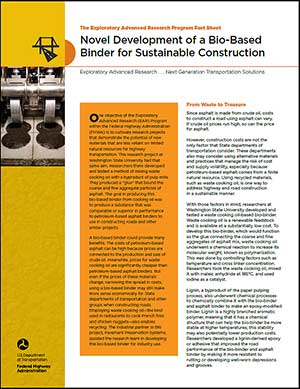U.S. Department of Transportation
Federal Highway Administration
1200 New Jersey Avenue, SE
Washington, DC 20590
202-366-4000
Federal Highway Administration Research and Technology
Coordinating, Developing, and Delivering Highway Transportation Innovations
| FACT SHEET |
| This fact sheet is an archived publication and may contain dated technical, contact, and link information |
| Publication Number: FHWA-HRT-18-030 Date: September 2018 |
Publication Number: FHWA-HRT-18-030 Date: September 2018 |
 |
The Exploratory Advanced Research ProgramNovel Development of A Bio-Based Binder for Sustainable Construction |
Exploratory Advanced Research - Next Generation Transportation SolutionsPDF Version (423 KB) PDF files can be viewed with the Acrobat® Reader® |
 © 2017 Department of Civil and Environmental Engineering, Washington State University. Researchers conducted a Hamburg wheel tracking test on a hot-mix bio-binder to evaluate any permanent deformation of the bio-binder. This device simulated traffic loading on a pavement that would be considered early age. The wheel load was 158 lbs, and the frequency of passing was 26 Hz. |
One objective of the Exploratory Advanced Research (EAR) Program within the Federal Highway Administration (FHWA) is to cultivate research projects that demonstrate the potential of new materials that are less reliant on limited natural resources for highway transportation. This research project at Washington State University had that same aim. Researchers there developed and tested a method of mixing waste cooking oil with a byproduct of pulp mills. They produced a “glue” that bound the coarse and fine aggregate particles of asphalt. The goal in producing this bio-based binder from cooking oil was to produce a substance that was comparable or superior in performance to petroleum-based asphalt binders to use in constructing roads and other similar projects.
A bio-based binder could provide many benefits. The costs of petroleum-based asphalt can be high because prices are connected to the production and sale of crude oil. Meanwhile, prices for waste cooking oil are significantly cheaper than petroleum-based asphalt binders. But even if the prices of these materials change, narrowing the spread in costs, using a bio-based binder may still make more sense economically for State departments of transportation and other groups when constructing roads. Employing waste cooking oil—the kind used in restaurants to cook French fries and chicken nuggets—also enables recycling. The industrial partner in this project, Pavement Preservation Systems, assisted the research team in developing this bio-based binder for industry use.
Since asphalt is made from crude oil, costs to construct a road using asphalt can vary. If crude oil prices run high, so can the price for asphalt.
However, construction costs are not the only factor that State departments of transportation consider. These departments also may consider using alternative materials and practices that manage the risk of cost and supply volatility, especially because petroleum-based asphalt comes from a finite natural resource. Using recycled materials, such as waste cooking oil, is one way to address highway and road construction in a sustainable manner.
With those factors in mind, researchers at Washington State University developed and tested a waste cooking oil-based bio-binder. Waste cooking oil is a renewable feedstock and is available at a substantially low cost. To develop this bio-binder, which would function as the glue connecting the coarse and fine aggregates of asphalt mix, waste cooking oil underwent a chemical reaction to increase its molecular weight, known as polymerization. This was done by controlling factors such as temperature and cross linker concentration. Researchers took the waste cooking oil, mixed it with maleic anhydride at 185°C, and used iodine as a catalyst.
Lignin, a byproduct of the paper pulping process, also underwent chemical processes to chemically combine it with the bio-binder and asphalt binder to make an epoxy-modified binder. Lignin is a highly branched aromatic polymer, meaning that it has a chemical structure that can help the bio-binder be more stable at higher temperatures; this stability may also potentially lower production costs. Researchers developed a lignin-derived epoxy or adhesive that improved the road performance of the bio-binder and asphalt binder by making it more resistant to rutting or developing well-worn depressions and grooves.
After the researchers created the bio-binder, they then made a hot-mix bio-binder and a hot-mix epoxy-modified bio-binder. The bio-binder and epoxy-modified bio-binder were mixed with aggregates in a hot drum, and the mixes were cured at a compaction temperature for 2 hours. Following that, the researchers used a gyratory compactor to compact the hot-mix epoxy bio-binder and the hot-mix bio-binder.
